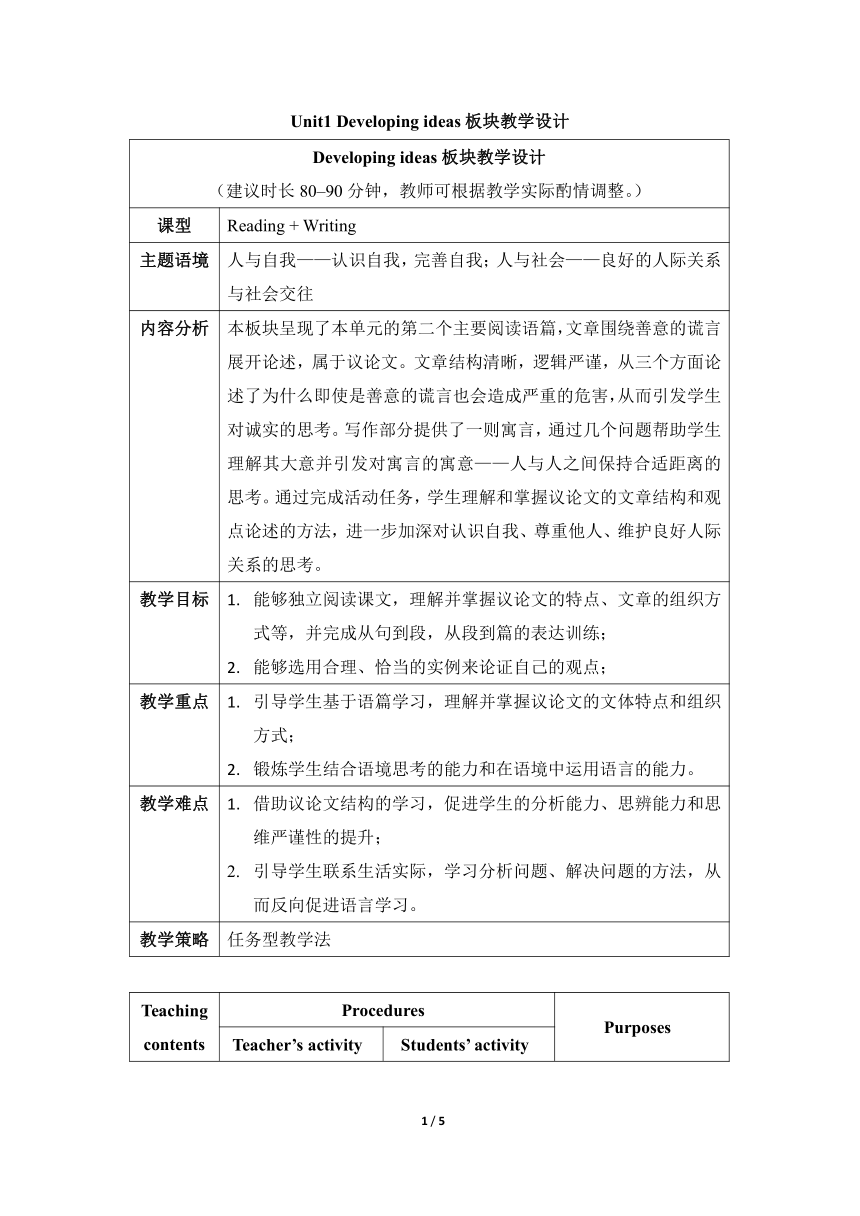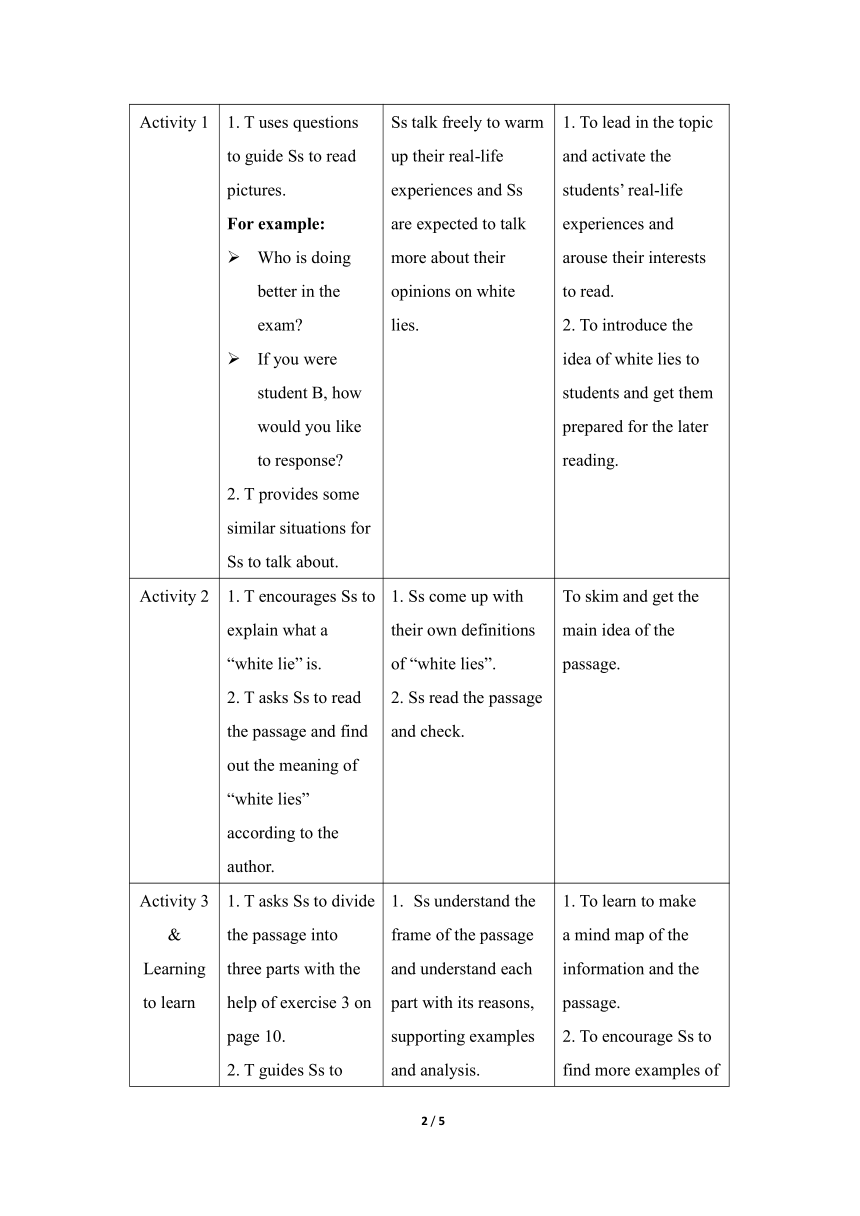外研版(2019)高中英语必修第三册Unit 1 Knowing me, Knowing you Developing ideas板块教学设计(表格式)
文档属性
| 名称 | 外研版(2019)高中英语必修第三册Unit 1 Knowing me, Knowing you Developing ideas板块教学设计(表格式) |  | |
| 格式 | docx | ||
| 文件大小 | 28.5KB | ||
| 资源类型 | 教案 | ||
| 版本资源 | 外研版(2019) | ||
| 科目 | 英语 | ||
| 更新时间 | 2023-02-28 16:14:33 | ||
图片预览


文档简介
Unit1 Developing ideas板块教学设计
Developing ideas板块教学设计 (建议时长80–90分钟,教师可根据教学实际酌情调整。)
课型 Reading + Writing
主题语境 人与自我——认识自我,完善自我;人与社会——良好的人际关系与社会交往
内容分析 本板块呈现了本单元的第二个主要阅读语篇,文章围绕善意的谎言展开论述,属于议论文。文章结构清晰,逻辑严谨,从三个方面论述了为什么即使是善意的谎言也会造成严重的危害,从而引发学生对诚实的思考。写作部分提供了一则寓言,通过几个问题帮助学生理解其大意并引发对寓言的寓意——人与人之间保持合适距离的思考。通过完成活动任务,学生理解和掌握议论文的文章结构和观点论述的方法,进一步加深对认识自我、尊重他人、维护良好人际关系的思考。
教学目标 能够独立阅读课文,理解并掌握议论文的特点、文章的组织方式等,并完成从句到段,从段到篇的表达训练; 能够选用合理、恰当的实例来论证自己的观点;
教学重点 引导学生基于语篇学习,理解并掌握议论文的文体特点和组织方式; 锻炼学生结合语境思考的能力和在语境中运用语言的能力。
教学难点 借助议论文结构的学习,促进学生的分析能力、思辨能力和思维严谨性的提升; 引导学生联系生活实际,学习分析问题、解决问题的方法,从而反向促进语言学习。
教学策略 任务型教学法
Teaching contents Procedures Purposes
Teacher’s activity Students’ activity
Activity 1 1. T uses questions to guide Ss to read pictures. For example: Who is doing better in the exam If you were student B, how would you like to response 2. T provides some similar situations for Ss to talk about. Ss talk freely to warm up their real-life experiences and Ss are expected to talk more about their opinions on white lies. 1. To lead in the topic and activate the students’ real-life experiences and arouse their interests to read. 2. To introduce the idea of white lies to students and get them prepared for the later reading.
Activity 2 1. T encourages Ss to explain what a “white lie” is. 2. T asks Ss to read the passage and find out the meaning of “white lies” according to the author. 1. Ss come up with their own definitions of “white lies”. 2. Ss read the passage and check. To skim and get the main idea of the passage.
Activity 3 & Learning to learn 1. T asks Ss to divide the passage into three parts with the help of exercise 3 on page 10. 2. T guides Ss to frame each part with the following questions: Why do we always tell white lies, though it’s wrong What examples are mentioned in this part What is the analysis of the writer Ss understand the frame of the passage and understand each part with its reasons, supporting examples and analysis. 2. Ss fill in the blanks in exercise 3 on page 10 and think about the writing pattern of an argumentative essay, which may be applied to the writing tasks later. 1. To learn to make a mind map of the information and the passage. 2. To encourage Ss to find more examples of white lies of their own and tell the differences between a lie and a white lie and inspire Ss to get further understanding of the theme value.
Think & Share T gets Ss to go back to the poem lines and think about its meaning in the context. Ss think and share with the class what they would do in the situation described in the passage Ss think and share with the class their understandings of Walter Scott’s poem. To arouse Ss’ deep understanding and the thinking of the passage.
Activity 4 T asks Ss to work in groups and talk about the importance of honesty. Ss follow the instructions on page 10 exercise 4 and make it into a mini speech. To let Ss think further and learn to use the proper examples to support their opinions.
Activity 5 T asks Ss to read the fable. While reading, T reminds Ss to pay special attention to the title and the ending. Ss understand that the passage is about dilemma, and not about porcupine. Ss understand that the passage is about finding ideal distance, and not about being independent. 3. Finish exercise 5 on page 11. To get the main idea of the fable and understand the message it conveys.
Activity 6 T guides Ss to go through the passage in details. Ss understand the fable and write down the summary and the viewpoint by completing the notes in exercise 6 on page 11. To summarize the viewpoint and get prepared for the writing task.
Activity 7 1. T encourages Ss to work in groups to share more supporting examples of the same dilemma in their real lives. 2. T asks Ss to combine their viewpoints and their examples together and write it into a passage. 1. Ss work together, list examples and pick out the most reasonable ones. 2. Ss follow the useful expressions on page 11 while writing. To practice writing an argumentative essay with the given structures and sentence patterns.
Activity 8 1. T shows the criteria of a good composition and demonstrates how to judge a composition. 2. T asks students to show their essays to the class, and invites others to make comments. Ss share and perform peer evaluation. To improve writing skills through peer evaluation.
1 / 5
Developing ideas板块教学设计 (建议时长80–90分钟,教师可根据教学实际酌情调整。)
课型 Reading + Writing
主题语境 人与自我——认识自我,完善自我;人与社会——良好的人际关系与社会交往
内容分析 本板块呈现了本单元的第二个主要阅读语篇,文章围绕善意的谎言展开论述,属于议论文。文章结构清晰,逻辑严谨,从三个方面论述了为什么即使是善意的谎言也会造成严重的危害,从而引发学生对诚实的思考。写作部分提供了一则寓言,通过几个问题帮助学生理解其大意并引发对寓言的寓意——人与人之间保持合适距离的思考。通过完成活动任务,学生理解和掌握议论文的文章结构和观点论述的方法,进一步加深对认识自我、尊重他人、维护良好人际关系的思考。
教学目标 能够独立阅读课文,理解并掌握议论文的特点、文章的组织方式等,并完成从句到段,从段到篇的表达训练; 能够选用合理、恰当的实例来论证自己的观点;
教学重点 引导学生基于语篇学习,理解并掌握议论文的文体特点和组织方式; 锻炼学生结合语境思考的能力和在语境中运用语言的能力。
教学难点 借助议论文结构的学习,促进学生的分析能力、思辨能力和思维严谨性的提升; 引导学生联系生活实际,学习分析问题、解决问题的方法,从而反向促进语言学习。
教学策略 任务型教学法
Teaching contents Procedures Purposes
Teacher’s activity Students’ activity
Activity 1 1. T uses questions to guide Ss to read pictures. For example: Who is doing better in the exam If you were student B, how would you like to response 2. T provides some similar situations for Ss to talk about. Ss talk freely to warm up their real-life experiences and Ss are expected to talk more about their opinions on white lies. 1. To lead in the topic and activate the students’ real-life experiences and arouse their interests to read. 2. To introduce the idea of white lies to students and get them prepared for the later reading.
Activity 2 1. T encourages Ss to explain what a “white lie” is. 2. T asks Ss to read the passage and find out the meaning of “white lies” according to the author. 1. Ss come up with their own definitions of “white lies”. 2. Ss read the passage and check. To skim and get the main idea of the passage.
Activity 3 & Learning to learn 1. T asks Ss to divide the passage into three parts with the help of exercise 3 on page 10. 2. T guides Ss to frame each part with the following questions: Why do we always tell white lies, though it’s wrong What examples are mentioned in this part What is the analysis of the writer Ss understand the frame of the passage and understand each part with its reasons, supporting examples and analysis. 2. Ss fill in the blanks in exercise 3 on page 10 and think about the writing pattern of an argumentative essay, which may be applied to the writing tasks later. 1. To learn to make a mind map of the information and the passage. 2. To encourage Ss to find more examples of white lies of their own and tell the differences between a lie and a white lie and inspire Ss to get further understanding of the theme value.
Think & Share T gets Ss to go back to the poem lines and think about its meaning in the context. Ss think and share with the class what they would do in the situation described in the passage Ss think and share with the class their understandings of Walter Scott’s poem. To arouse Ss’ deep understanding and the thinking of the passage.
Activity 4 T asks Ss to work in groups and talk about the importance of honesty. Ss follow the instructions on page 10 exercise 4 and make it into a mini speech. To let Ss think further and learn to use the proper examples to support their opinions.
Activity 5 T asks Ss to read the fable. While reading, T reminds Ss to pay special attention to the title and the ending. Ss understand that the passage is about dilemma, and not about porcupine. Ss understand that the passage is about finding ideal distance, and not about being independent. 3. Finish exercise 5 on page 11. To get the main idea of the fable and understand the message it conveys.
Activity 6 T guides Ss to go through the passage in details. Ss understand the fable and write down the summary and the viewpoint by completing the notes in exercise 6 on page 11. To summarize the viewpoint and get prepared for the writing task.
Activity 7 1. T encourages Ss to work in groups to share more supporting examples of the same dilemma in their real lives. 2. T asks Ss to combine their viewpoints and their examples together and write it into a passage. 1. Ss work together, list examples and pick out the most reasonable ones. 2. Ss follow the useful expressions on page 11 while writing. To practice writing an argumentative essay with the given structures and sentence patterns.
Activity 8 1. T shows the criteria of a good composition and demonstrates how to judge a composition. 2. T asks students to show their essays to the class, and invites others to make comments. Ss share and perform peer evaluation. To improve writing skills through peer evaluation.
1 / 5
